11+ Ways to Experience Mi’kmaq Culture in Nova Scotia

The lands we now know as Canada have had different identities over the centuries. Long before European settlers arrived, numerous Indigenous groups lived and explored these areas and still do to this very day. What is now Nova Scotia as well as the majority of New Brunswick, parts of Gaspe in Quebec and the entirety of Prince Edward Island is the traditional territory of the L’nu, now known as the Mi’kmaq (pronounced mee-guh-maw).
Nova Scotia is referred to as Mi’kma’ki, meaning last water or land in their language. There are 13 Mi’kmaq communities scattered across the province, many of which have tourism offerings that allow locals and visitors alike to learn more about their traditions.
Just like each of the Indigenous cultures across the country, the Mi’kmaq have unique legends, history, language and spirituality that are incredibly beautiful. When visiting the province, I highly recommend diving deeper to learn more with these amazing ways to experience Mi’kmaq culture in Nova Scotia!
Disclaimer: This post may contain affiliate links where I may receive a kickback at no extra cost to you. It helps keep IBB alive so thank you!
TABLE OF CONTENTS
11 Ways to Experience Mi’kmaq Culture in Nova Scotia
The spelling of the word ‘Mi’kmaq’ is the plural, non-possessive conjugation of ‘Ni’kmaq’ which can mean my friends, my allies or my family. This immediately speaks to the welcoming nature of the Mi’kmaq and it shines through in each and every interaction.
It was an incredible honour to partake in these experiences while working with Tourism Nova Scotia. I’d like to remind my readers that we are guests in these spaces and to always arrive with an open mind and heart. It’s a privilege to have these opportunities so please be respectful throughout them!
I’ve organized these experiences by destination to help make planning easier. I have to say though, all of these tours, workshops and cultural spaces are worth checking out as you’ll learn so much about the Mi’kmaq culture in Nova Scotia!

Some of the Exhibits at Membertou Heritage Park
Membertou First Nation
Our first destination takes to to Cape Breton Island or Unama’ki meaning land of fog in Mi’kmaq. This where you’ll find the community of Membertou. It’s located near the town of Sydney, the largest city on the island and the ferry terminal for those looking to visit Newfoundland by water.
Named after Grand Chief Henri Membertou who was the leader of the Kespukwitk area for the majority of the 16th Century, Membertou is one of the five Mi’kmaq communities on Cape Breton Island. They have a number of great offerings to expand your knowledge of Mi’kmaq culture!
Explore Membertou Heritage Park
Since June 2012, Membertou Heritage Park has been sharing the history of the community and surrounding area as well as its traditions on this five-acre site. Explore the exhibits where you’ll find information about L’sipukt (Sydney Harbour), how the Mi’kmaq of the area lived before colonization, their traditions, governing structures and more. It’s also home to Canada’s largest ash basket at 7 feet in height!
One prominent event you will learn about is the relocation of the community of Kuntewiktuk, also known as the Kings Road Reserve. This thriving community sat “too close” to European settlers and after years of pressure led by lawyer Joseph A Gillies, a judicial hearing was held in 1915 which led to the forced removal of Mi’kmaq families from their homes to a new location just outside the city limits of Sydney where Membertou is located now. This was the first time an Indigenous community was legally forced to locate in Canadian history. Learn more here.
- Lindz Learning to Bead
- Finished Beaded Necklace
Learn How to Bead
Membertou Heritage Park also offers a variety of cultural workshops, one of which being learning how to bead your own earrings or a necklace. Andrea provides everything you’ll need to complete the project and shares the best techniques for crafting your own masterpiece. Chat with her as she shares a variety of stories from the community and spend a few hours getting crafty. I can’t remember the last time I sat down and made something by hand so this was a real treat!
Time will absolutely fly during this two hour workshop. It costs $25 per person which covers Andrea’s time, expertise and the supplies provided. You’ll also enjoy some luskinikn (what the Mi’kmaq call bannock) with molasses along with coffee and tea as you bead!
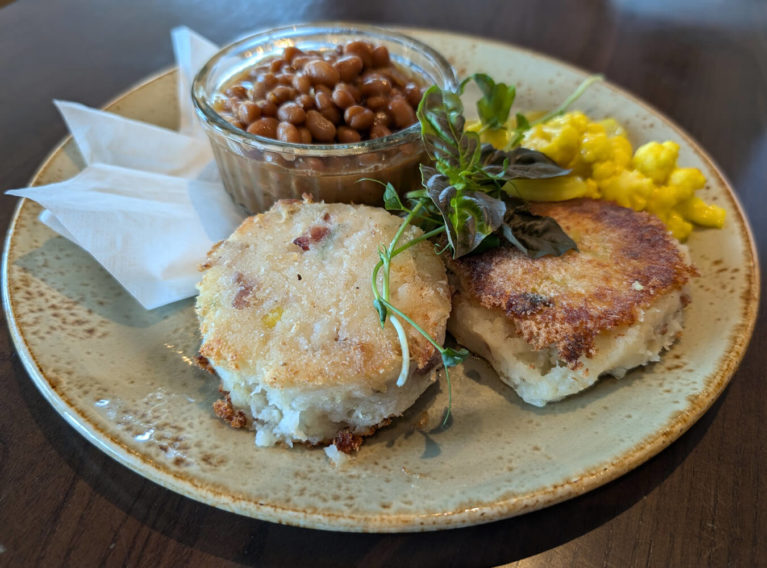
Fish Cakes at Kiju’s Restaurant
Enjoy a Meal at Kiju’s Restaurant
If you’re looking for a taste of Nova Scotia as well as some some Mi’kmaq eats, head to the Membertou Trade and Convention Centre to grab a bite to eat at Kiju’s Restaurant. Meaning mother in Mi’kmaq, kiju speaks to the traditional role of Mi’kmaq women who nourished families for generations.
Their menu is crafted by Cape Breton local, Executive Chef Shaun Zwarun. His passion for the culinary world began at an early age as he would often help his father prepare food for his family and gatherings. His dishes feature local ingredients sourced from surrounding vendors and farmers whenever possible to highlight the best in regional cuisine.
One of the highlights of the menu has to be their Four Cent Bread Skillet where their traditional Mi’kmaq fry bread (luskinikn) is served with an artichoke parmesan dip and sweet grass molasses. Though I personally opted for their Fish Cakes & Beans where these tasty salt cod and potato patties are crafted with caramelized onions and served alongside baked beans as well as green tomato chow. You can’t go wrong with their seafood chowder either!
- Cultural Ambassador David Meuse Guiding the Tour
- Lindz Snacking on Edible Plants
Take a Guided Medicine Walk
If you’re going to do any of the experiences in Membertou, I highly recommend joining cultural ambassador David Meuse for a guided medicine walk.
Beginning at the Membertou Trade and Convention Centre, David will take you on a short bus tour of Membertou as he shares a brief history of the community, including taking you to Membertou’s original location before the forced eviction to the community’s current location. Afterwards, you’ll be dropped off at one of the accesses to the Greenlink Trail system where your walk will officially begin.
David is an absolute fountain of information as he shares about the local flora and fauna along with their incredible medicinal properties. It was incredible to hear stories how plants like how Alder tree bark can be made into a tea which has detoxifying properties and how chewing on a small piece of willow can relieve a headache just like Tylenol or Aspirin. I don’t want to give too much away but I promise you’ll be blown away by just how much the natural world that surrounds us can heal!
Tours cost $45 plus taxes/fees and the experience can vary in length, depending on your group size and the amount of time you have. No matter how much time you spend on the medicine walk, you’ll be treated to powerful stories and songs that David is kind enough to share with you. He’ll even teach you some Mi’kmaq words and phrases which helps you connect even more with the culture! Click here to book now.
- Lindz Wrapping the Frame of Her Dreamcatcher
- Lindz & Ashlyn Holding Their Finished Dreamcatchers
Learn How to Make a Dreamcatcher
Another fantastic cultural experience offered by David at the Membertou Trade and Convention Centre is his dreamcatcher workshop.
After supplying you with all the materials you need to complete a dreamcatcher, David will take you step by step through the process of making it. While traditionally the frame is made from willow branches, you’ll use a metal hoop as your foundation and spend the next few hours weaving the middle of your dreamcatcher. He’ll show you how to add beads as you do so to add your own personal flair. Similar to the beading workshop with Andrea, you’ll nibble on luskinikn as you create your masterpiece and sip on delicious blueberry tea!
The workshop lasts two hours and costs $25 per person plus taxes and fees. Click here to book now.
- Lindz Inside Building 24
- Skinning an Eel for the Mi’kmaq Demonstration
Visit the Fortress of Louisbourg
Another stop that’s not to be missed in Unama’ki (Cape Breton Island) is the Fortress of Louisbourg National Historic Site. Located 40 minutes from Membertou, you can easily spend a full date exploring this Parks Canada location. While this site focuses on the history of the original French fortress that was founded in 1713, it discusses the relationship between the original Mi’kmaq people and the French settlers.
During your visit, head to building 24 where you can learn about this relationship as well as some of the cultural traditions of the Mi’kmaq. It’s certainly fitting since this building was originally the home of Michel le Neuf de la Vallière, one of the first to develop relationships with the Mi’kmaq community during his time as commandant at Port Toulouse.
Explore the exhibits inside to learn about the mutual respect shared between the two nations and how they renewed this relationship through ceremony each year. There are a number of interactive displays where you can touch a variety of items like traditional musical instruments and recreations of cooking apparatuses.
One thing I found very interesting is that once the fortress fell from the final time, the Mi’kmaq distanced themselves from the British. This isn’t the first time I’ve heard of Indigenous people choosing to lessen their ties because of British rule, and always makes me wonder how different history would have been if the French had won over the British.
One thing you won’t want to miss is the Mi’kmaq demonstration which occurs at 1:00 pm daily during the summer season. During my visit, a local interpreter from Eskasoni First Nation showed us how they skin eels and explained the process of turning it into a leather for a variety of uses.
- Lindz & Ashlyn Hanging Out Along the Trail
- Demonstration of a Traditional Mi’kmaq Instrument
Eskasoni First Nation
Our final destination in Unama’ki (Cape Breton Island) is Eskasoni, the largest Mi’kmaq community in the world. Eskasoni comes from the Mi’kmaq word we’keistonqnik meaning where the fir trees are plentiful. Visitors will want to set their GPS for Goat Island for a guided tour with Eskasoni Cultural Journeys!
Nestled within the Bras d’Or Lakes Unesco Biosphere Reserve, Goat Island features a captivating 2.4 kilometre trail. We followed our guide, Matthew, who was fantastic as he shared about the history of Goat Island and led us around the trail to fellow community members. Each highlighted a different aspect of Mi’kmaq life and culture from traditional tools and weapons to their original instruments and dances. Our experience was impeded a little as Mama Nature decided a quick downpour was necessary during our tour, but we still enjoyed it all the same!
Afterwards, I highly recommend walking the trail again as there are a variety of interpretive signs that will share additional information. Plus there are so many great photo spots that you won’t have a chance to enjoy during your guided experience!
Guided tours cost $48 plus taxes/fees and are available twice daily Monday through Friday at 10:00 am and 1:00 pm. Click here to book now and see what other tours are available from Eskasoni Cultural Journeys.
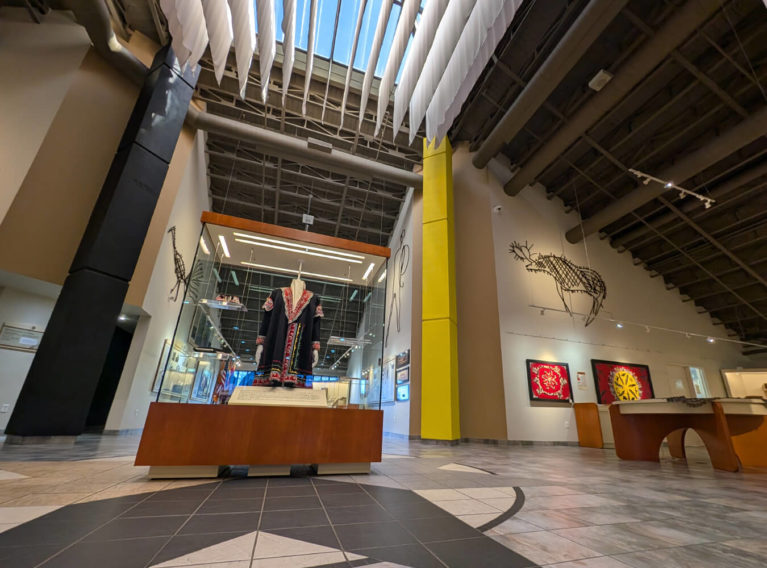
Historic Regalia on Display at the Millbrook Cultural & Heritage Centre
Millbrook First Nation
Millbrook First Nation is located near the town of Truro, known as end of the water’s flow or Wagobagitik in the Mi’kmaq language. Within it, you’ll find the Millbrook Cultural & Heritage Centre which is a must when visiting the area.
Step inside to see the various exhibits dedicated to the history of Millbrook First Nation and Mi’kmaq cultural traditions. There are over 24,000 artifacts in their collection and while you can’t see them all, a large number of them are on display including bone tools, beaded artifacts and birchbark creations. One of my favourite exhibits was learning more about the Mi’kmaq alphabet as well as some proper pronunciations of Mi’kmaq words.
If Millbrook Cultural & Heritage Centre sounds familiar, you may remember this news story from early 2023. Heather Stevens, senior heritage interpreter and the manager of the Millbrook Cultural & Heritage Centre worked for over a decade to reunite Mi’kmaq regalia including moccasins, a jacket, a pipe and a brooch said to have been crafted by a woman from either Sipekne’katik or Millbrook that was housed in Australia’s Museum Victoria for over 130 years. It’s in incredible condition and it was so impactful for Millbrook First Nation to be reconnected with this piece of their culture. Read more on their website here.
It’s also home to Kluscap (Glooscap) which is said to be the first human in Mi’kmaq traditions. Created from a bolt of lightening hitting sand, this mystical entity is the focus of many Mi’kmaq legends. In the courtyard behind the centre, you’ll see a giant 12 metre (40 foot) state of Kluscap which is said to be the tallest human-like statue in all of what is now Canada!
- Petroglyph Replica & Mi’kmaq Monument
- Alex Showing Us Some Petroglyphs
Kejimkujik National Park
Derived from the Mi’kmaq word Kejimkuji’jk, meaning little fairies in the Mi’kmaq language, Kejimkujik National Park was created in 1968. It protects a stunning old growth forest, a variety of rare wildlife and important traditional waterways for the Mi’kmaq people. 27 years later, Kejimkujik also received the designation of National Historic Site, making it the first national park to carry both titles.
In the warmer months, Kejimkujik National Park offers a variety of interpretive programming to help educate visitors about Mi’kmaq culture and their 4000+ years of history on these lands. Stop in at the visitors centre to see their exhibits during your stay and check out the full schedule of activities. There are many great tours and experiences but you need to sign up for many of them in advance. Take a look at the schedule here to see what will be offered during your visit!
RELATED: Kejimkujik also has a satellite location on the opposite coast, Kejimkujik Seaside. Located near Port Joli, it’s quite different than the terrain you’ll find here! Click here to read more about it.
Experience the Petroglyphs
Kejimkujik National Park is home to one of the largest collections of petroglyphs in North America. As some of the only remaining evidence of written Mi’kmaq history, they have helped historians and local Mi’kmaq communities uncover more of the region’s history.
There are over 500 petroglyphs within Kejimkujik National Park depicting a variety of images. However, they are in a restricted area and can only be accessed on one of the scheduled guided tours. Head to the Merrymakedge P1 parking lot and meet your guide by the Mi’kmaq Monument where your guide will start the tour by sharing about a few of the common motifs and their importance in Mi’kmaq culture, some of which have been incorporated into the Mi’kmaq Monument.
Afterwards, follow your guide along the trail to the edge of Kejimkujik Lake where you’ll see the sacred petroglyphs site. It’s mandatory to remove your footwear to protect the soft shale rock to ensure these carvings can be seen for years to come! While some vandalism occurred before this area was fully protected, you can see a number of iconic petroglyphs that represent important events and symbols from centuries ago. Learn about the stories these images represent as you feel the deep connection to this spiritual site.
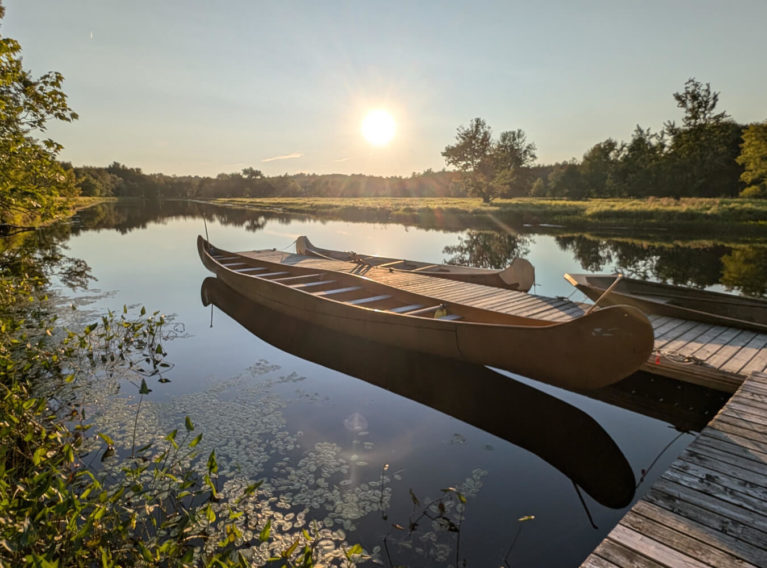
18-Person Canoe at Sunset
Big Canoe Big Sky Guided Paddle
Experience the night sky of Nova Scotia’s only dark-sky preserve from the waters of Kejimkujik Lake! Originally known as Fairy Lake, explore the magical wonder as the stars twinkle above you.
Set out in a great canoe that seats 18 people as the sun begins to descend behind the horizon. As you slowly melt into the rhythm of the paddle, your experienced guides share Mi’kmaq legends that transcend time and space as they connect the sky world and water world.
As darkness falls, you’ll be captivated by the constellations above as the Milky Way slowly emerges like an intricate painting dancing across the night sky. Listen for fish as they greet the surface and let the calmness of the loon’s call wash over you. It’s an absolutely magical experience and easily one of my favourite things to do in Kejimkujik National Park.

Todd Labrador at his Birch Bark Canoe Workshop
Birch Bark Canoe Building with Todd Labrador
Head to the southern end of Merrymakedge Beach where you’ll find an unassuming path through the forest. This will lead you right to the Birch Bark Canoe Shop where you’ll see Todd Labrador and his family hard at work.
As one of the few birch bark canoe builders left in the world, Todd works out in the open to allow others to watch the process of creating his next vessel. Stop by anytime between 12:30 pm and 3:30 pm Thursday through Sunday to ask questions about making a canoe, his inspiration and his experiences.
I was blown away when he shared with me that he’s completely self taught, though canoe making is in his heritage as his great grandfather made birch bark canoes and baskets. It was incredible to watch him put the finishing touches on this 14 foot canoe as he pointed out the unique characteristics that differentiate a Mi’kmaq canoe and what makes them ocean worthy versus those for rivers and lakes. Don’t be surprised if you spend a few hours of your day here as you’ll be mesmerized by his craftsmanship!
SOMETHING TO NOTE: While Todd Labrador travels all around the world sharing his craft and teaching others, rumour has it he will be back to create another birch bark canoe at Kejimkujik National Park and Historic Site in summer 2025!
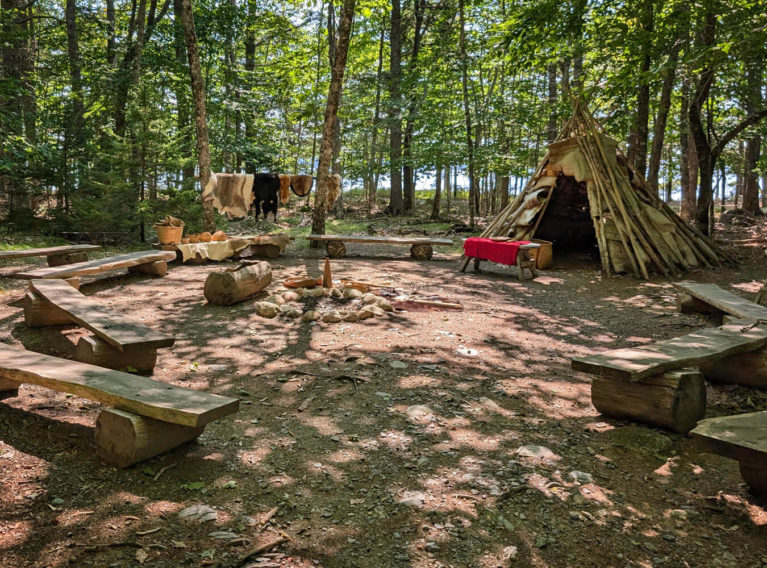
Wejisqalia’ti’k Mi’kmaq Encampment
Take a Tour of Wejisqalia’ti’k
Get a glimpse of the past and see how the Mi’kmaq would have lived during stationary living periods at Wejisqalia’ti’k. Meaning we grew up from the earth, this replica village will show visitors various aspects of every day life. Learn the differences between tipis and wigwams, see the tools made from bone and antlers before steel and iron were introduced with colonization and touch pelts from various animals used in Mi’kmaq traditions to craft clothing and other items.
My favourite part had to be playing some of the traditional Mi’kmaq games. I quickly discovered how uncoordinated I am as I couldn’t manage to complete the hand and bone game but I wasn’t too shabby at Waltes! Sort of like a dice game, you have to try and flip six flat coin-like objects made of caribou bone by slamming a circular wooden dish into the table top to make them bounce. It certainly takes a few tries to get the hang of it but it’s addicting to play once you do! Read the full rules of Waltes here.
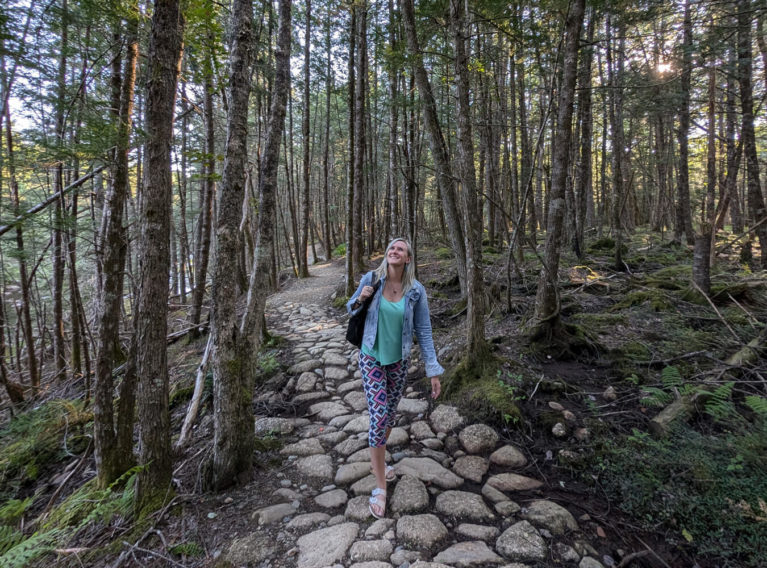
Lindz Walking Along the Ukme’k Trail
Explore the Ukme’k Trail
If you’re unable to attend any of the experiences during your visit to Kejimkujik National Park, you can connect with Mi’kmaq culture by exploring the park’s newest trail.
Meaning twisted in the Mi’kmaq language, the Ukme’k Trail is 6.3 kilometres in length as this winding path loosely follows the Mersey River along the traditional Mi’kmaq canoe route known as Oqomkikiaq. It connects to the Slapfoot and Merrymakedge trails to become 13.5 kilometres in its entirety, allowing you to explore a large part of the park entirely on foot.
The trail has a number of interesting geological features that add to the entire experience of trekking the trail. While I only got to experience a small section of it, I absolutely loved the rock crossings that looked almost like cobblestones along the trail. Located just northwest of Mill Falls, it makes you feel like you’ve stepped into a forested wonderland!
Looking For More Indigenous Experiences in What is Now Canada?
Visit Wikwemikong & Learn The True History of Manitoulin Island
See Why Everyone Should Experience a Pow Wow
More Experiences to Learn About Mi’kmaq Culture in Nova Scotia
As you can imagine, these aren’t the only ways you can expand your knowledge about this beautiful culture! There are a number of other activities spread out across the province to further your understanding. Here are some more options for your next visit to Mi’kma’ki!
Halifax Citadel National Historic Site – Head into the fortress to view the Citadel’s newest exhibit, A City Shaped by Conflict. Here you’ll find artwork by renowned local Mi’kmaq artist, Leonard Paul, which illustrates Kjipuktuk, or “The Great Harbour” as well as various scenes from Mi’kma’ki.
Halifax Museum of Natural History – While it was undergoing an exhibit revamp during my visit, some of their permanent displays speak to the Mi’kmaq culture. Don’t miss “This Is What I Wish You Knew” as it explores Indigenous self-identity from members of the urban Indigenous community in Halifax through their personal stories.
Georges Island National Historic Site – It’s no secret that the Mi’kmaq were the first people to live in Kjipuktuk over 10,000 years ago. Head to Georges Island where you can learn about Elpaqkwitk, “water splashed on it by the waves” as it was a key gathering place for the Mi’kmaq as well as an important harvesting area before, during and long after the arrival of European settlers.
Grand-Pré National Historic Site – While this site is a testament to the resilience of the Acadians, here you can also learn about the peaceful relationship the Acadians had with the Mi’kmaq. Learn how the Acadians were welcomed in 1680 as they worked together to build a system of diking and draining to convert several thousand acres of marshlands into agricultural land suitable for farming. Read more here.
Looking for More Nova Scotia Content?
Don’t Miss Out on This Epic Road Trip from Halifax to Yarmouth
Check Out All The Great Things to Do in Yarmouth & The Acadian Shores
Disclaimer:
This article was crafted in partnership with Tourism Nova Scotia but all of the content and opinions outlined here are honest and speak to my personal experience, as always.

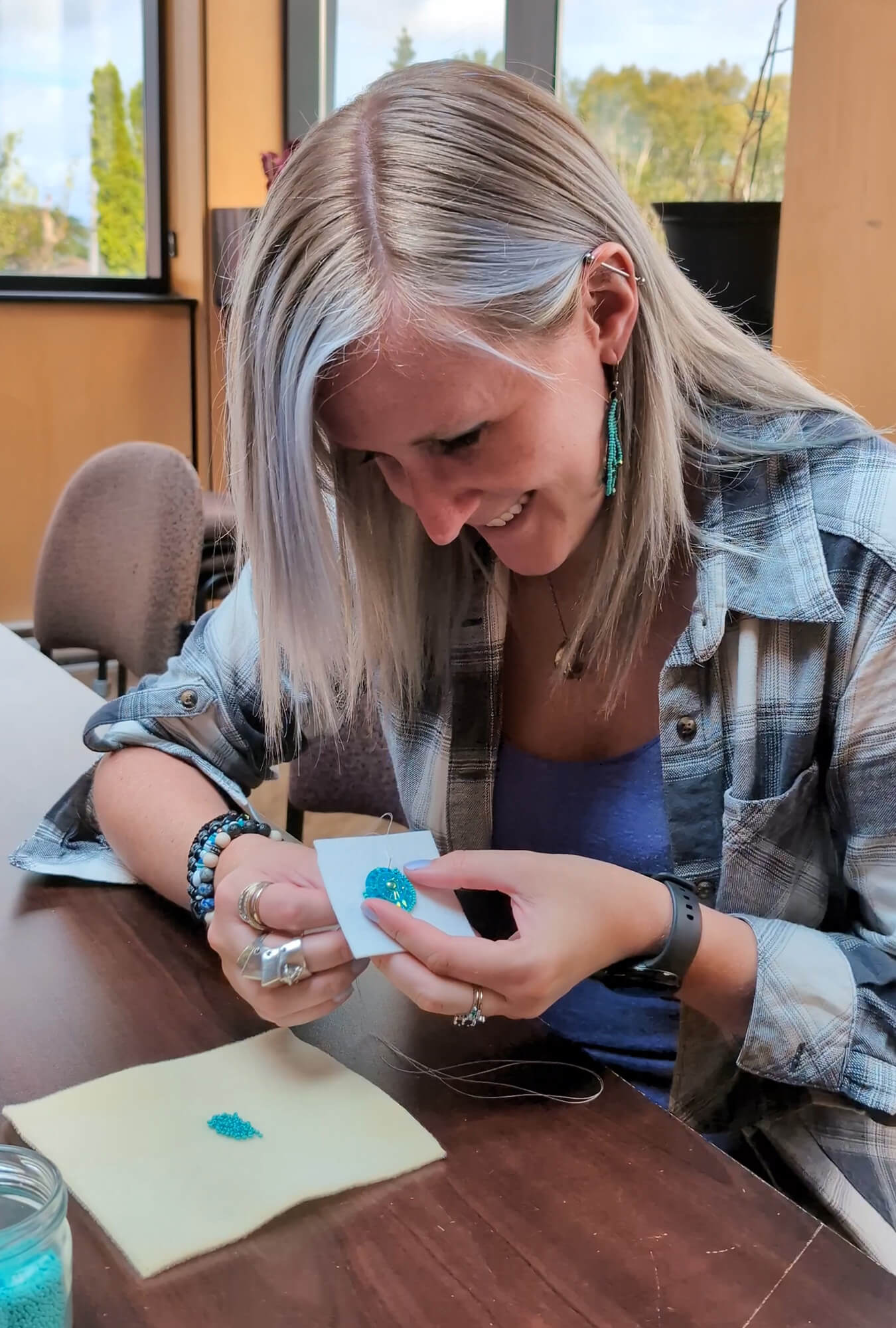
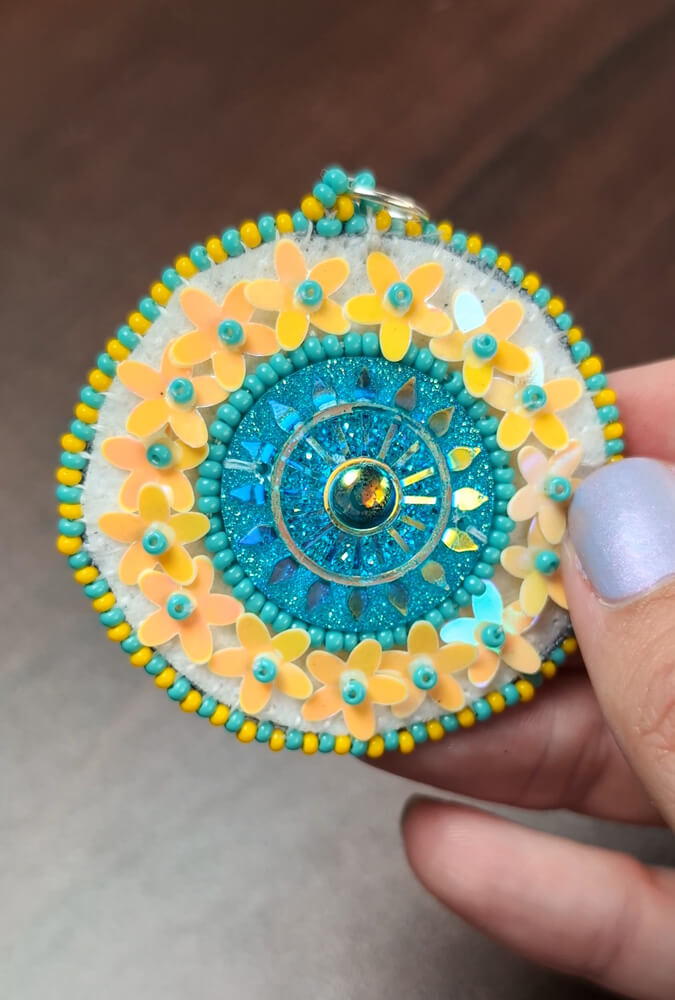
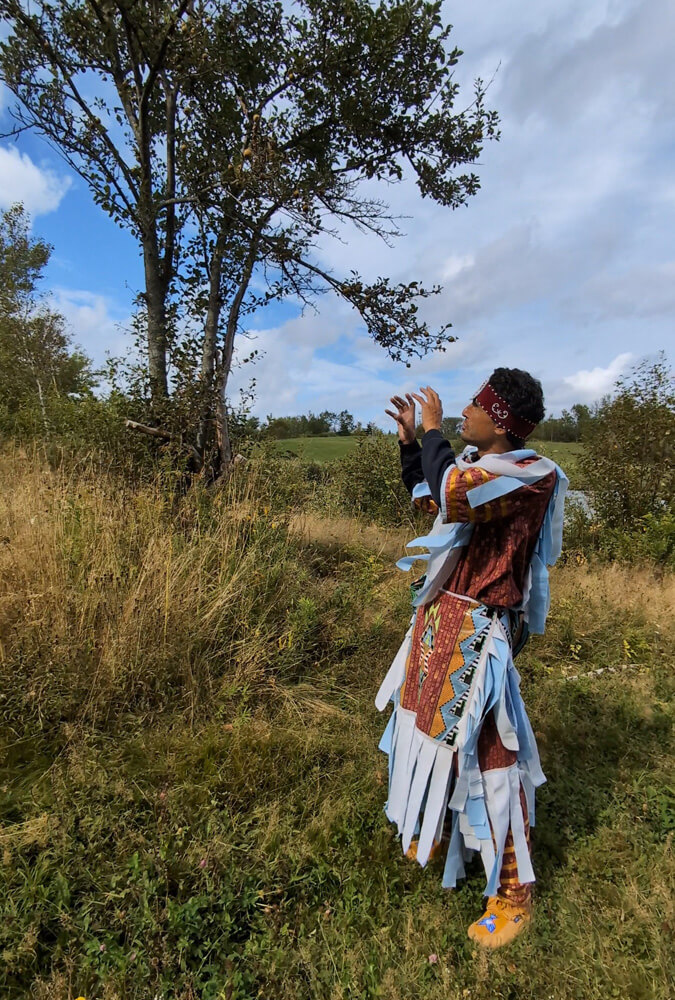

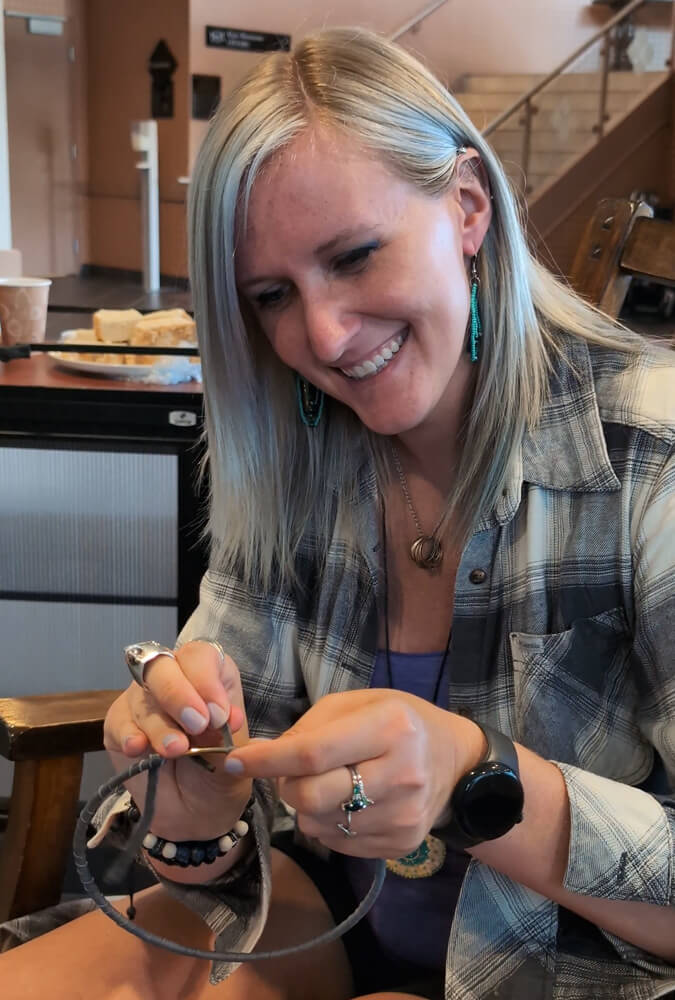


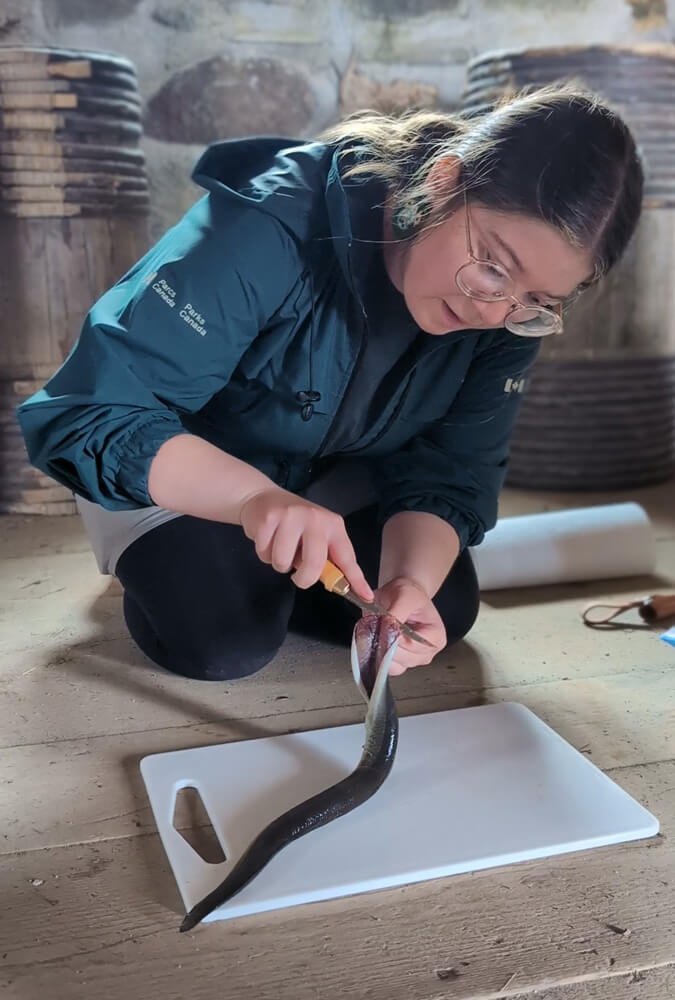
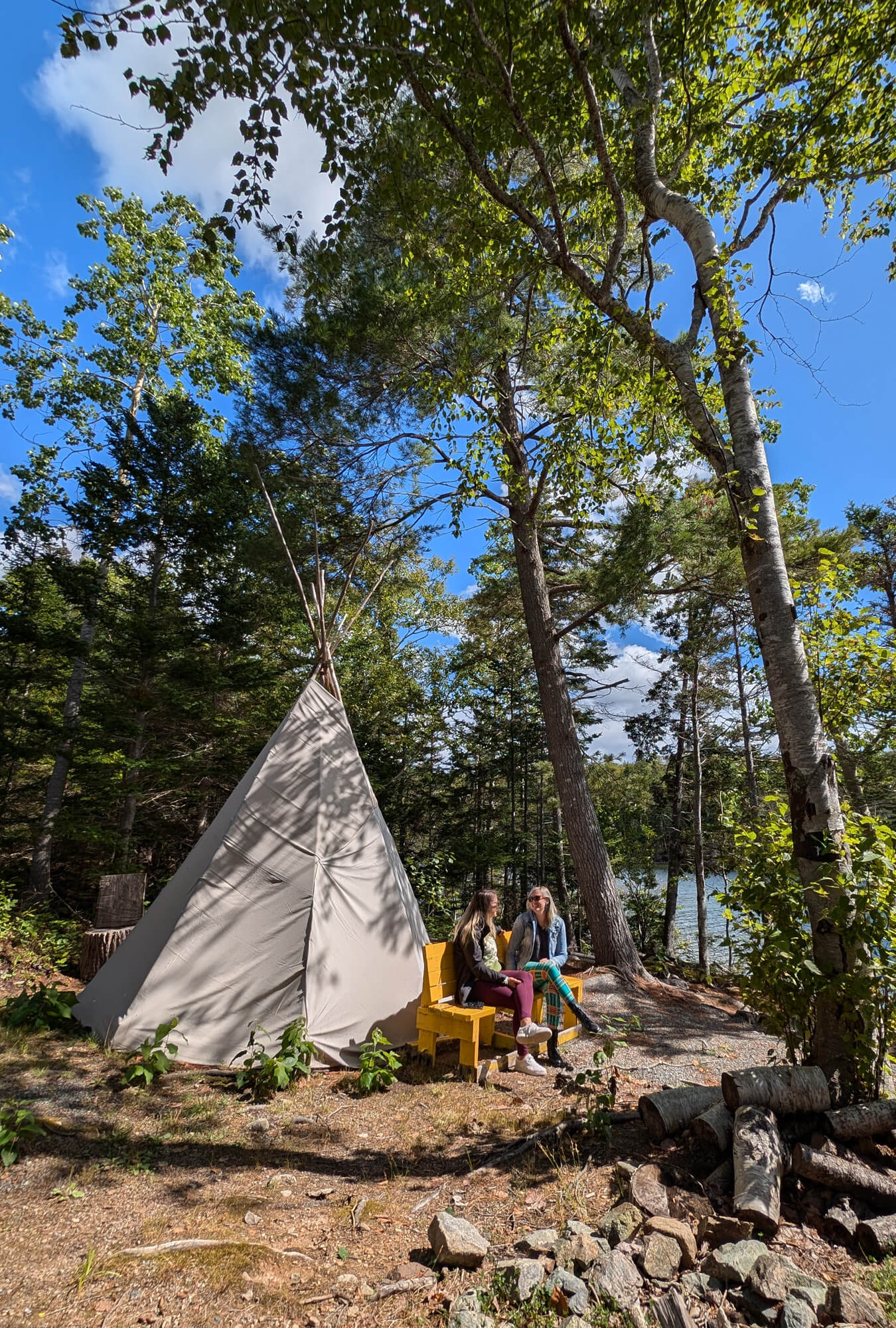
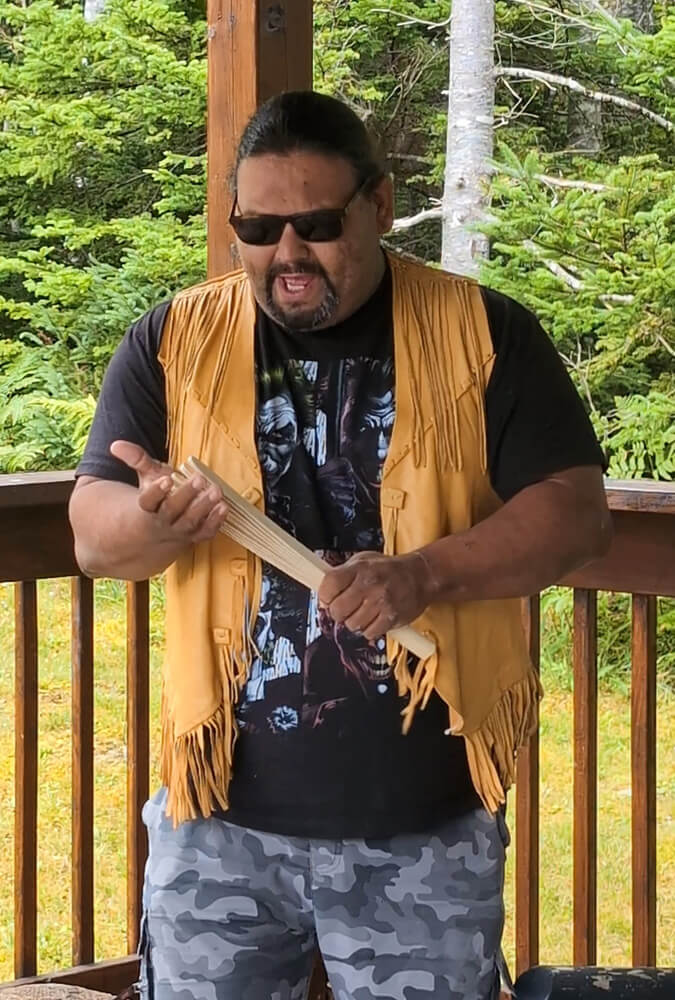
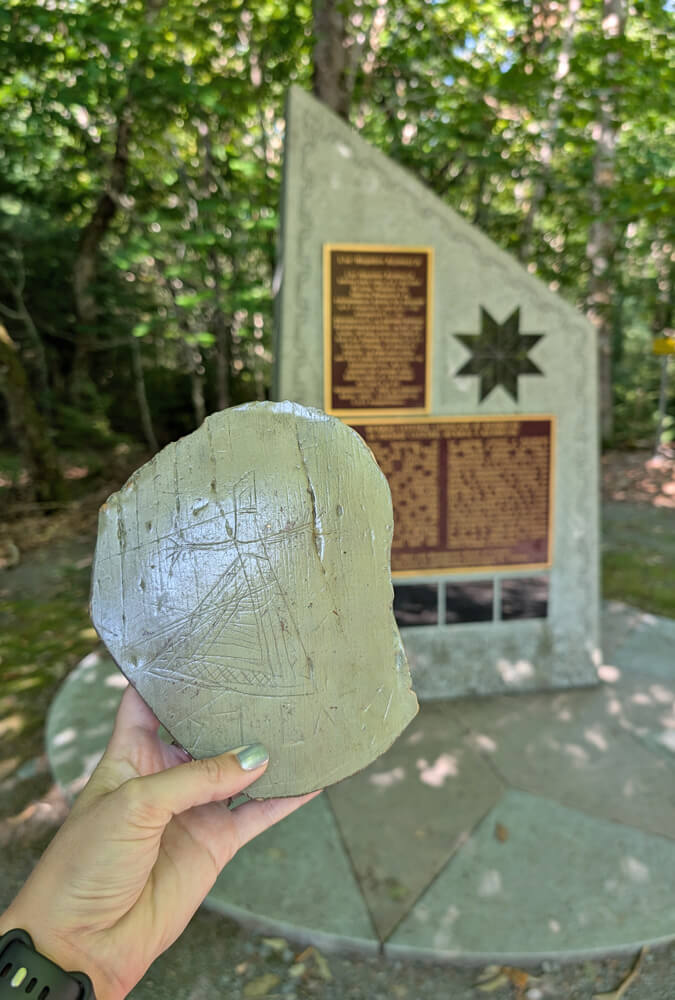
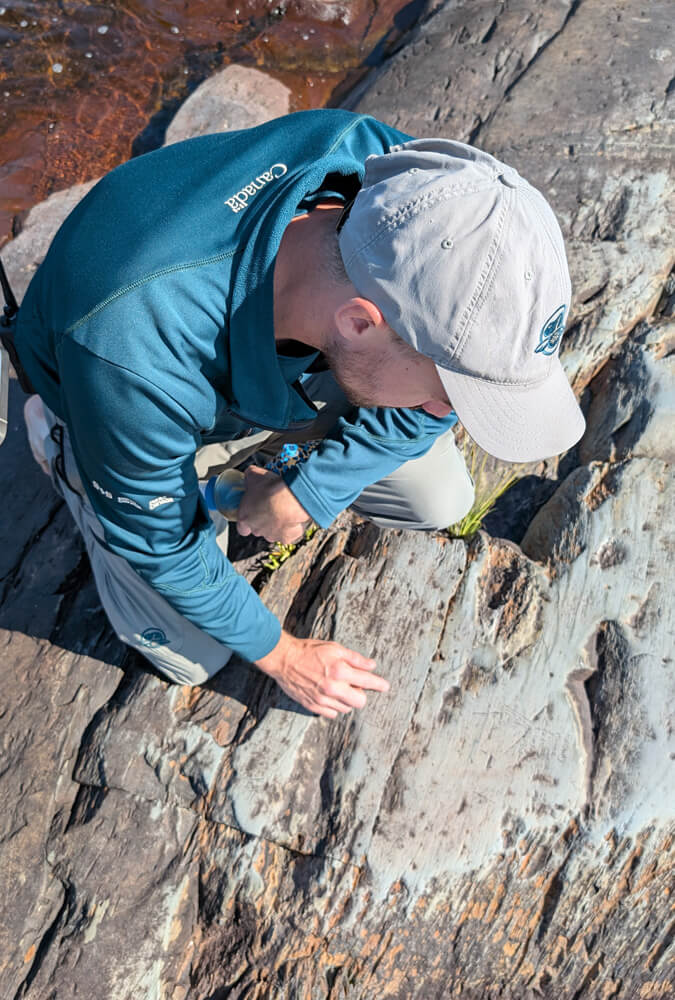










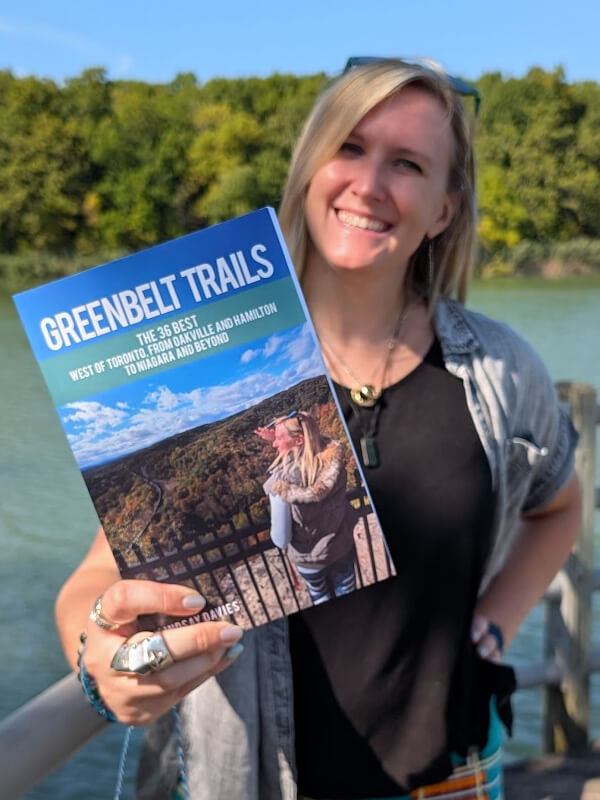


Share Your Thoughts